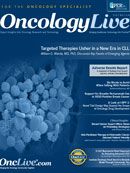Publication
Article
Oncology Live®
G-202 Represents Novel Approach for Attacking Advanced HCC
Author(s):
Prodrug chemotherapy is an exciting approach by which higher concentrations of cytotoxic or biologically active agents can be achieved at a tumor site while avoiding the systemic toxicity of a non-cell-specific toxin.
Devalingam Mahalingam, MD, PhD
Hematologist/Oncologist
Cancer Therapy & Research Center
The University of Texas Health Science Center
Prodrug chemotherapy is an exciting approach by which higher concentrations of cytotoxic or biologically active agents can be achieved at a tumor site while avoiding the systemic toxicity of a non-cell-specific toxin. One promising example of this strategy is the development of the cytotoxic agent thapsigargin, which is derived from the Thapsia garganica plant once known in Mediterranean cultures as the “death carrot.” Efforts to engineer this agent into an effective therapy for hepatocellular carcinoma (HCC) are advancing.
Thapsigargin can kill a broad spectrum of cancer cells but with detrimental effects on normal endothelial cells, fibroblasts, and osteoblasts. The molecular mechanism of action is attributed to the induction of apoptosis (cell death) by a pronounced increase in cytosolic calcium due to blockade of sarcoplasmic/endoplasmic reticulum calcium ATPase (SERCA) pump to which thapsigargin binds with high affinity.
Due to the highly toxic characteristics of thapsigargin, the challenge was how to deliver the agent to tumors while causing the least impact on normal cells and tissue. The answer was to develop a relatively nontoxic form of thapsigargin; that is, the prodrug, which can be converted into the active cytotoxic agent at a particular location, specifically at the tumor site, for effective anticancer treatment.
In this pursuit, G-202 was generated by coupling a prostate-specific membrane antigen (PSMA)-specific peptide to an analogue of the potent thapsigargin. The daunting task was to identify a tumor-specific protein from which an appropriate peptide could be linked to the drug and make the drug inactive until the peptide could be cleaved from the drug only at the tumor site by that specific protein, such as PSMA, a glutamate carboxypeptidase type II enzyme that cleaves the acidic amino acids glutamate and aspartate. PSMA was of interest because of its unique presence in prostate cancer and most tumor endothelial cells, but not in normal vasculature or normal tissue epithelium. Of note, PSMA is also found in the vasculature of 90% of HCC tumors.
The immense promise of G-202 as a future practice- changing therapy is apparent because this compound has biologic activity only after proteolytic cleavage by PSMA occurs at the tumor site. Normal healthy cells are no more susceptible to unwanted cytotoxic activity because thapsigargin is blocked by the masking peptide, which is selectively cleaved by PSMA in PSMA-positive human tumors such as prostate and HCC tumors. Within the neovasculature, the nontoxic prodrug G-202 is converted by hydrolysis into the active cytotoxic analogue of thapsigargin, 12ADT-Asp, which has the ability to trigger apoptosis by a mechanism similar to that of thapsigargin. Compared with thapsigargin alone, G-202 can achieve higher concentrations of the active agent at the tumor site while avoiding systemic toxicity.
When tested against a panel of human cancer xenografts in vivo, G-202 produced substantial tumor regression at doses that were minimally toxic to the host. These encouraging results led to a phase I open-label, single-arm, dose-escalation study in patients with advanced cancer. The study was designed to evaluate the safety and pharmacokinetics of G-202 as well as to identify a phase II dosing regimen. GenSpera, Inc, based in San Antonio, is sponsoring the research.
In all, 44 patients were recruited for the study at three US institutions, including the Cancer Therapy & Research Center at UT Health Science Center in San Antonio, which was the lead patient enrollment site. Of the participants, 28 were included in the dose-escalation portion of the study and 16 were part of an expanded cohort. Results were presented at the AACR-NCI-EORTC International Conference on Molecular Targets and Cancer Therapeutics.1
Most of the toxicities reported were mild and of grade 1 severity, with some patients experiencing increased creatinine/acute kidney injury/acute renal failure, nausea, and infusion-related reaction, ameliorated by prophylactic IV hydration, IV antiemetics, and steroid administration on the day of infusion. Five patients with HCC were enrolled in the expansion cohort. This group averaged 6 cycles of treatment per patient (range, 2-12 cycles), for a total of 29 cycles among all patients. An encouraging outcome was the observation of stable disease for more than 9 cycles in each of 2 patients.
This has led to the opening of a multicenter phase II study evaluating G-202 as second-line therapy for patients with HCC after treatment failure with sorafenib (Nexavar).2 If the early clinical finding holds true in controlling progression of HCC with minimal toxicity to patients, and a successful clinical development program is completed, G-202 could one day become a treatment option for patients with advanced HCC.
New therapies are urgently needed for this patient population. HCC ranks third in cancer deaths worldwide, with ~360,000 deaths annually. The majority (75%) of the world’s patients with HCC are in Asia-Pacific Rim countries. In the United States, the incidence of HCC is increasing and has risen at a faster rate in the Latino/Hispanic population than among non-Hispanic whites. Currently, the only FDA-approved drug for HCC is sorafenib, which gained an indication for unresectable HCC in 2007 after clinical trial findings demonstrated a 3-month improvement in overall survival versus placebo.
References
- Mahalingam D, Cetnar J, Wilding G, et al. A first-in-human, phase I clinical study of G-202, a thapsigargin-based prostate- specific membrane antigen (PSMA) activated prodrug, in patients with advanced solid tumors. Poster presented at: AACR-NCI-EORTC International Conference on Molecular Targets and Cancer Therapeutics; October 19-23, 2013; Boston MA. Abstract B244.
- NIH Clinical Trials Registry. www.ClinicalTrials.gov. NCT01777594.






























%20(2)%201-Recovered-Recovered-Recovered-Recovered-Recovered-Recovered-Recovered-Recovered-Recovered-Recovered-Recovered-Recovered-Recovered-Recovered-Recovered-Recovered-Recovered.jpg?fit=crop&auto=format)
%20(2)%201-Recovered-Recovered-Recovered-Recovered-Recovered-Recovered-Recovered-Recovered-Recovered-Recovered-Recovered-Recovered-Recovered-Recovered-Recovered-Recovered-Recovered.jpg?fit=crop&auto=format)
